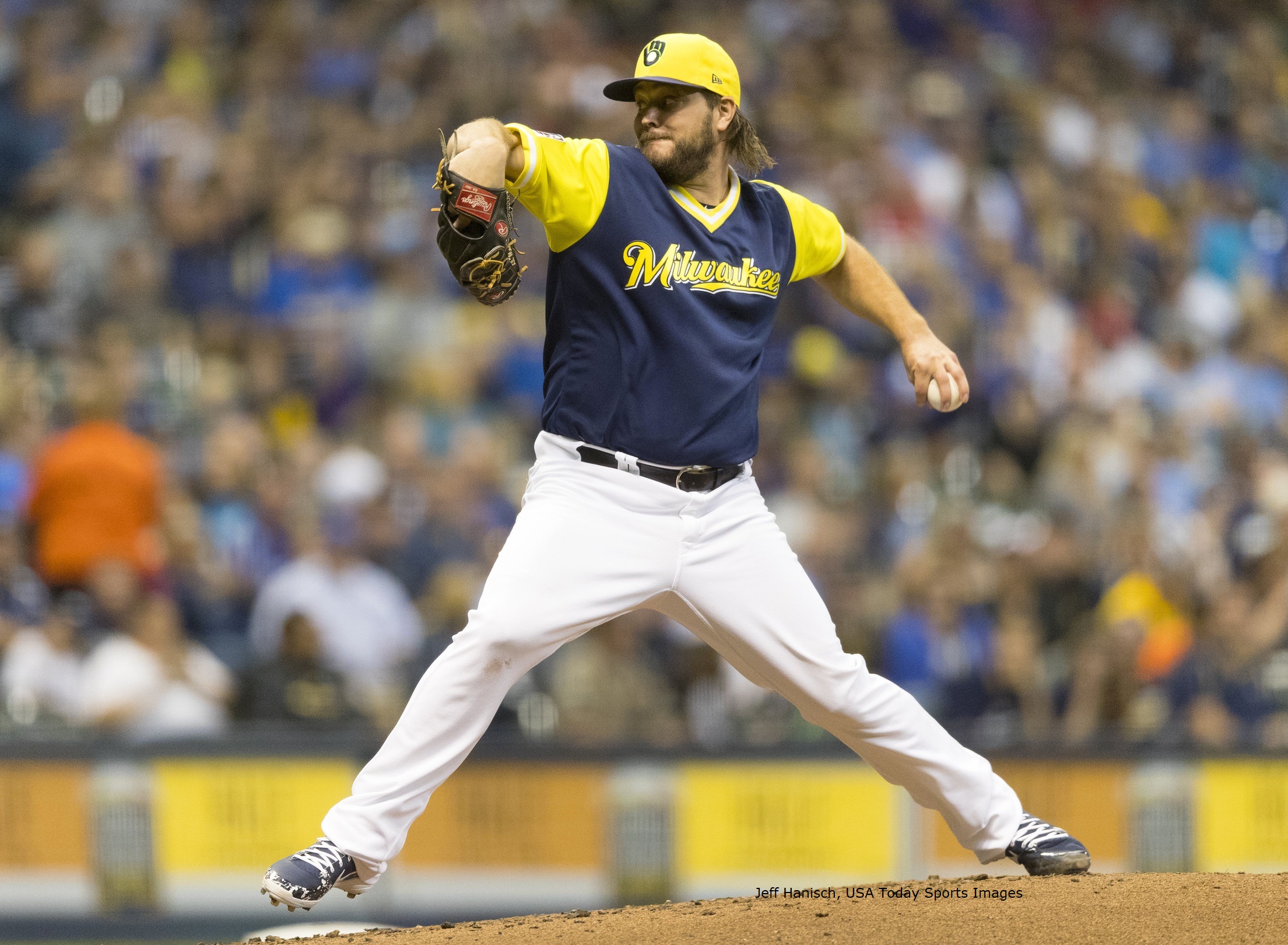For better or worse, one of the most popular narratives surrounding the Brewers over the last few months has been this: Milwaukee needs to add another starting pitcher. It’s an easy thing to understand: The ragtag crew of hurlers preventing runs in the Brewers’ rotation lacks a brand-name “ace,” and most of that group has been knocked around a bit lately. When the Brewers did add a starter last week in the sometimes-great Gio González, it stood to reason that some other Brewers pitcher was going to get bumped from the rotation. Casual baseball fans and national analysts took a glance at the depth chart, and figured that Wade Miley was probably that pitcher. Fangraphs, for example, reminded readers that the Brewers are “a team in an absolutely nuts Wild Card race starting 2018 Wade Miley on purpose” and that “any innings you can give to a competent pitcher who isn’t Wade Miley matter.”
Miley, at first blush, was low-hanging fruit for this kind of punchline. The southpaw’s 2017 season was an inescapable disaster, and his 5.61 ERA / 5.27 Fielding Independent Pitching (FIP)/ 7.61 Deserved Run Average (DRA) cocktail suggests that no amount of bad luck was to blame for his misfortune (his 5.3 walks per nine innings could have told you that, too). It was an ugly season, any way you slice it. If that were Miley’s line this year, he’d absolutely be the first man sent to the ‘pen.
Of course, that’s not Miley’s line this season. By the most basic (and, to a contending team, arguably the most important) of standards, 2018 Wade Miley has been quietly excellent: His results are beyond reproach. In 11 games started for Milwaukee spanning 57.7 innings (and including an injury-shortened one-out effort against Cleveland in May), Miley has pitched to an astonishing 2.18 ERA. He’s allowed three earned runs once this season, in a five-inning effort that resulted in a no-decision. Every other time out, he’s held his opponents to two earned runs or fewer.
Dip below the surface and the picture isn’t quite so rosy, true. But it’s rosy enough. Miley’s FIP for the year is a strong 3.72, and his DRA is 4.24, both bests since 2013. He’s striking out only around six batters per nine innings, which is a career low among full seasons, but not too out of the ordinary. Miley has never relied on blowing hitters away with elite velocity or ridiculous breaking balls.
Rather, when he’s at his best, Miley uses pinpoint control to compensate for middling stuff, giving him the results of a mid-rotation starter despite a repertoire that suggests a back-end or swing role. Never was this more evident than in his terrific rookie season for the Diamondbacks in 2012, when Miley spun 194.7 innings of 3.33 ERA / 4.18 DRA ball and rode his 1.7 BB9 to an All-Star nod and a second-place finish in Rookie of the Year voting (he finished just seven points behind Bryce Harper). He’s never quite equalled that output, but he’s come close, with a 4.23 DRA the following year and a 4.39 mark in 2014.
This season represents a welcome step back in that direction. Fans can thank the cutter, a pitch that Miley dabbled with only on occasion before deploying last year with 11.8 percent frequency. This year, that number is up to 38.5 percent, trading places and then some with his so-so sinker. The cutter finally gives Miley a viable weapon against right-handed hitters, who have hit Miley for a .775 OPS on his career. Perhaps it’s the novelty of the new pitch (and new division), but righties are batting just .160 against the cutter this year, which Miley likes to ride low and in. Miley has also wrangled his free passes down to a respectable 3.4 per nine innings, and he’s been even better lately: Over his last five starts (28.3 innings), that number is down to 2.2; over his last three, it’s sitting pretty at 1.6.
Of course, running the ball over the plate with greater consistency comes with its own inherent set of risks. But Miley has a much better defense behind him in Milwaukee than he did in Baltimore. Despite a greater number of balls in play, his Walks and Hits per Inning Pitched (WHIP) is down almost half a point from its ugly apex. Miley continues to be a solid ground ball pitcher, but his excellent 0.47 HR9 number is unsustainably low, as is the career-best .269 Batting Average on Balls in Play (BABIP) allowed. He’s stranding over 80 percent of runners on base. Many of these numbers scream regression. Crucially, though, they doesn’t scream regression to “horrible.” Just to somewhere in the vicinity of that 4.24 DRA.
Miley is pitching well at the right time for Milwaukee. (Paradoxically, his injury-shortened season may have something to do with that. Miley has historically run out of gas in September, with a 5.08 ERA in just shy of 200 autumn innings. This year, he’s fresh.) He’s not the sort of pitcher you’d want starting a Wild Card game, never mind this year’s sterling bubble-gum stats. But he’s not exactly a liability of the “I can’t believe a contending team is giving this guy the ball” variety, either. He’s rediscovered his command with the Brewers and has experienced a good amount of luck. The result is an average pitcher, just as he’s been for much of his career. That makes him a perfectly fine bet to keep the team in the game for fifteen or so outs. Even as Gio González warms the bullpen bench, Miley has earned the right to soak up some more innings down the stretch. And with Junior Guerra struggling and Zach Davies something of an unknown after his return from injury, González will get his chance, as well.
Photo: Jeff Hanisch, USA Today Sports Images
